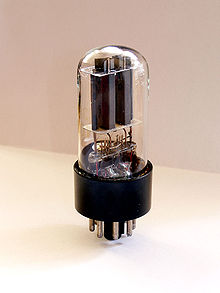6SN7
The 6SN7 is a widespread electron tube (double triode ) with an octal base, in which the triode systems of two 6J5 triodes are housed in a single tube for reasons of space economy .
It appeared on the US tube market in 1939 as a steel tube, but it wasn't until 1941 that it became established as the 6SN7GT with a glass housing. Together with its many later variants, it played a similarly important role in the electronics industry during these years as its successor, the famous miniature double triodes with Noval sockets ECC81, ECC82 and ECC83 .
In the black and white television sets from the early television era, which were equipped with numerous tubes, the 6SN7 was one of the irreplaceable standard tubes of the tube industry because of its versatile application possibilities.
The tube found its best-known application in the English Williamson amplifier, one of the first hi-fi- compatible amplifier concepts, and in the gigantic IBM-SAGE computer system of the 1950s.
The professional version of the 6SN7 is the 5692 (RCA).
The Russian / Soviet equivalent of the 6SN7 is 6H8C (Latin 6N8S), functionally analogous is the 6Н1П (Latin 6N1P).
Web links
- Data sheet for the 6SN7 ( Memento from October 12, 2007 in the Internet Archive )
- Data sheet 6SN7 (VEB plant for telecommunications) (PDF; 66 kB)
- Data sheet of the 6H8C (Russian + English) (PDF; 103 kB)

